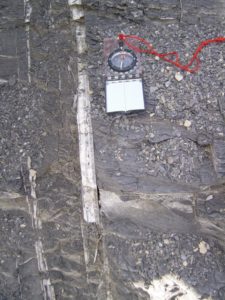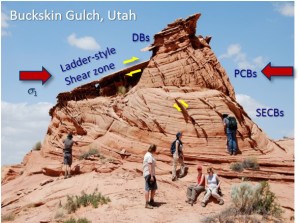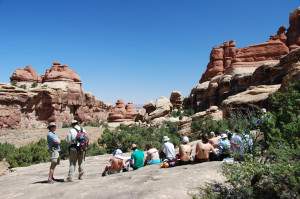Research
Geomechanics and structural geology are important parts of fields such as geothermal energy, oil and gas exploration and production, underground product storage, precious metals exploration, tectonics and mountain building, and geologic hazards such as earthquakes, induced seismicity, and rock-slope stability. They are also a means for understanding the geologic and tectonic evolution of other planets and satellites in our Solar System.
I have engaged in fundamental and applied scientific research with corporate scientists and engineers, international colleagues, and others into many of the areas that can add value in the oil and gas, precious minerals, underground storage, and mining sectors, with publications and presentations (invited and contributed) as appropriate.
Here’s a link to a Keynote presentation from June 2022
My research has spanned a range of areas that include geomechanics of subsurface integrity, underground natural gas storage facilities, growth of fault and fracture networks, and mechanics of deformation and compaction bands in porous granular solids through large deformations. These areas invoke fundamental physics of rock fracture mechanics, lithospheric deformation, and fluid transport that underpin basic and applied studies of energy exploration and development, seismic hazard assessment in naturally and industrially active areas, ground subsidence above depleting aquifers and petroleum reservoirs, and faulting and magmatic processes on planets such as Mars. The tools used involved appropriate combinations of geologic field characterization, space-borne remote sensing, engineering concepts, and computation using analytical and numerical techniques. The synergies and challenges involved in any one of these areas required and instilled an innovative, creative, non-traditional, quantitative, versatile set of capabilities in students who participate in research on my team or in these project areas.
From indexing services:
- Citations: 8,442 (Google Scholar); 7,867 (ResearchGate); 5,151 (publons/Web of Science)
- 43,710 reads (ResearchGate)
- h-index: 51 (as of 4/25/2024)
Citations Map
(publons/Web of Science; 7/19/2023)
Current Projects
I am working in the midstream Storage & Transport energy sector within the broad field of subsurface integrity, focusing on underground natural gas storage, petroleum geomechanics, structural geology, and rock mechanics. The opportunity space in this area is important to industry and to society. Primary emphases have included:
- Underground Hydrogen Storage — Geomechanics of reservoir seals (caprock, faults), site characterization, screening criteria
- International Energy Agency’s
 (IEA) Hydrogen Technology Collaboration Programme (Hydrogen TCP), Task 42: Underground Hydrogen Storage Workplan, from 2022–2024. Find out more at https://www.ieahydrogen.org/t
(IEA) Hydrogen Technology Collaboration Programme (Hydrogen TCP), Task 42: Underground Hydrogen Storage Workplan, from 2022–2024. Find out more at https://www.ieahydrogen.org/task/task-42-underground-hydrog en-storage/.  Subsurface Hydrogen Assessment, Storage, and Technology Acceleration (SHASTA) through Lawrence Livermore National Laboratory
Subsurface Hydrogen Assessment, Storage, and Technology Acceleration (SHASTA) through Lawrence Livermore National Laboratory- International Gas Union’s (IGU) Committee on Underground Gas Storage.
- International Energy Agency’s
- Underground Natural Gas Storage — Identification and mitigation of occurrences, with or without product loss, for facilities in depleted oil and gas fields, depleted aquifers, and solution-mined salt caverns
- Subsurface Integrity — Geologic hazards, barrier definition and implementation
- Statistical Hazard Assessment — Incorporating uncertainty using Bayesian methods to quantify historical occurrences of subsurface issues
|
Previous Projects (UT)
While at The University of Texas at Austin (UT) as Senior Research Scientist I applied reservoir geomechanics to problems in petroleum geoscience and engineering. Areas worked included:
- FRAC Consortium — Geomechanics of reservoir rocks and their overburdens; industry-funded consortium

Cementation in joints (one type of “natural fracture”) can reveal rates of crack growth, opening, and remote extension in the shale sequence
- CISR (Center for Integrated Seismicity Research) — Geologic and geomechanical studies of unconventional reservoirs; research consortium funded jointly by industry and State of Texas
Hydraulic stimulation of unconventional petroleum reservoirs depends in part on the type and degree of cementation in the natural fractures
Collaborative research with FRAC and CISR included applications of geomechanics to wastewater injection and induced seismicity, vertical hydrofracture propagation and completions in layered reservoirs, laboratory studies of subcritical crack propagation, and field and theoretical analysis of deformation and compaction bands in porous reservoir analog rocks.
I also instituted a focus on Subsurface Integrity of hydrocarbon fields and underground natural gas storage facilities. This was augmented with TopCorp training of oil and gas regulators from California.
Previous Projects (UNR)

A world-class exposure of deformation and compaction bands in eolian sandstone at the Buckskin Gulch, Utah site being worked by students from UNR’s Geomechanics-Rock Fracture Group
While on the faculty of the University of Nevada, Reno (UNR) I taught courses in geological engineering, rock mechanics, and structural geology at as well as graduate classes in planetary geology and geologic fracture mechanics to solve problems in field-based structure and tectonics on the Earth and other planets. Much of my research work on terrestrial and planetary problems was funded by NASA and involved international collaborations and colleagues at institutions such as the Université of Paris and Université Montpellier, France, and the University of Bergen, Norway.
Our research group at UNR was an innovator in applying geologic fracture mechanics to the Moon, Mars, and Mercury.
Our work at UNR utilized approaches developed in traditionally separate specialties, primarily field geology and engineering fracture mechanics, to address interrelated problems in rock and crustal mechanics and tectonics on the Earth and other planetary bodies. Our expertise in analyzing the rock mass mechanics, tectonics, and faulting of the Moon, Mercury, Mars, and Venus permitted the extension and modification of geomechanical concepts, developed for a particular set of P-T-x-gravity conditions (Earth), to a broader range of geologic contexts, such as Mars, in lithospheric structure and planetary evolution. Most of our work was funded by competitive grants from NASA with additional funding from the U.S. Department of Energy, international agencies, and private industry. My former students have generally gone on to exciting and rewarding careers in private industry and academia.
Geomechanics-Rock Fracture Group (UNR)

The Geomechanics–Rock Fracture Group participating in an international field tutorial with students and faculty from Norway in the Grabens of Canyonlands National Park, USA
While at UNR I led the Geomechanics-Rock Fracture Group. My graduate students, postdocs, and I worked on projects that ranged from petrography and thin-section analysis, to outcrop-scale mapping and analysis of the structural relationships, to regional-scale problems including orogenic belts and fault-fold relationships. We were recognized for using digital elevation models to deduce the geometry and nature of structures at depth, both on the Earth and other planets. Our graduate students have been sought after by employers in industry and academia for their versatility and creative approaches to solving structural and tectonic problems.
Structural geology and geomechanics can be integrated by applying field, laboratory, and theoretical tools to solve problems of academic and practical interest.
Some of our student project and research areas have included:
- Deformation of porous rocks and formation of deformation band arrays
- Growth and significance of compaction bands
- Fracture hydrology
- Growth and displacement-length scaling of fractures, faults and deformation bands
- Fault restriction and the development of linkages and relay-ramps in stratified sedimentary sequences
- Faulting and tectonics on Mars and other planets and satellites in the Solar System
- Structure and tectonic development of Valles Marineris, Mars
- Structural geology of impact craters and deformation at high strain rates
- Planetary slope stability
- Planetary thrust faults and thrust anticlines (wrinkle ridges)

Digital elevation models of Mars have been used extensively to characterize grabens in Tharsis and lobate thrust faults and other structures in the Martian lithosphere.